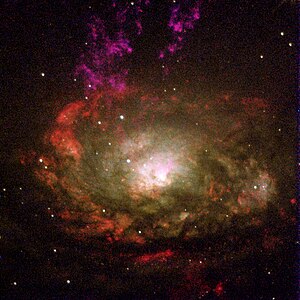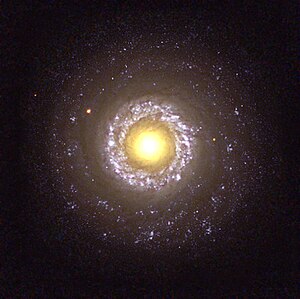Seyfert Galaxy

The Circinus Galaxy , a Type 2 Seyfert galaxy
|

The galaxy NGC 7742
|
Seyfert galaxies are spiral or irregular galaxies with a very bright galaxy core. The spectra of these nuclei show characteristic emission lines that are not excited by stars. Seyfert galaxies are a suborder of the Active Galactic Nuclei . The Seyfert galaxies were named after the astronomer Carl Keenan Seyfert , who studied them very intensively in the 1940s.
Appearance, classification into type 1 and type 2
Typical for Seyfert galaxies are the often very bright nuclei and electromagnetic spectra with very bright spectral lines of, among other things, hydrogen , helium , nitrogen and oxygen . The strength ratios of these lines differ significantly from those in HII regions that are excited by hot stars.
These spectral lines often show strong Doppler broadening , which indicate speeds of the emitting gas of up to 10,000 kilometers per second. Based on this broadening, Seyfert galaxies were originally classified into two different types:
- Type 2: only "narrow" lines up to about 1000 km / s wide;
- Type 1: additional "wide" line components of some lines with a width of up to 10,000 km / s.
Later on, Donald Osterbrock also defined intermediate types such as 1.5 and 1.9 in which broad components are only seen in some of the lines that they would have in Type 1. It turns out that forbidden lines with a low transition probability, which can only arise in thin gas, are always narrow in the spectrum. Broad components are only observed for allowed lines , which are also strongly emitted in dense gas because of their higher transition probability. In Seyfert-1 galaxies a compact and dense “ Broad Line Region ” and an extended, thinner “Narrow Line Region” are visible, in Seyfert-2 galaxies only the latter.
In addition, Seyfert galaxies emit strong radiation over large parts of the electromagnetic spectrum, from radio waves to microwaves , infrared , ultraviolet , X-rays and gamma rays . The intensity of the radiation emitted by the core can change noticeably within a year. It follows that the diameter of the emitting region must be less than a light year.
Energy source
Today, the energy source of Seyfert galaxies is generally considered to be the influx of matter onto a supermassive black hole . This can even lead to the surrounding galaxy being outshone by the core. There is a constant transition between the most luminous Seyfert galaxies and the even more extreme quasars .
The incident matter releases energy through friction, presumably in an accretion disk that surrounds the central black hole. The accretion disk is the source of a large part of the electromagnetic radiation emitted by the Seyfert galaxy, which then generates secondary phenomena such as the emission lines observed in visible light when it hits matter further out.
Unified models
Unified models do not explain the difference between type 1 and type 2 by the presence or absence of a broad line region. They assume that this is always there, but in Seyfert 2 galaxies it is obscured in our line of sight by dense interstellar matter and dust. In line with this idea, the broad spectral component of some Seyfert 2 galaxies can be observed in polarized light . The polarization shows that this light reached us in a roundabout way through scattering of hot gas or dust around the core. This effect was first discovered in the type 2 galaxy NGC 1068 . Unified models are further supported by the observation that X-rays from the core of the Seyfert galaxies normally show stronger traces of attenuation in type 2 objects than in type 1 objects.
literature
- C. Seyfert: Nuclear Emission in Spiral Nebulae. In: Astrophys. Journal. 97, 28 (1943).
- D. Osterbrock: Astrophysics of Gaseous Nebulae and Active Galactic Nuclei. University Science Books, Mill Valley 1989, ISBN 0-935702-22-9 .